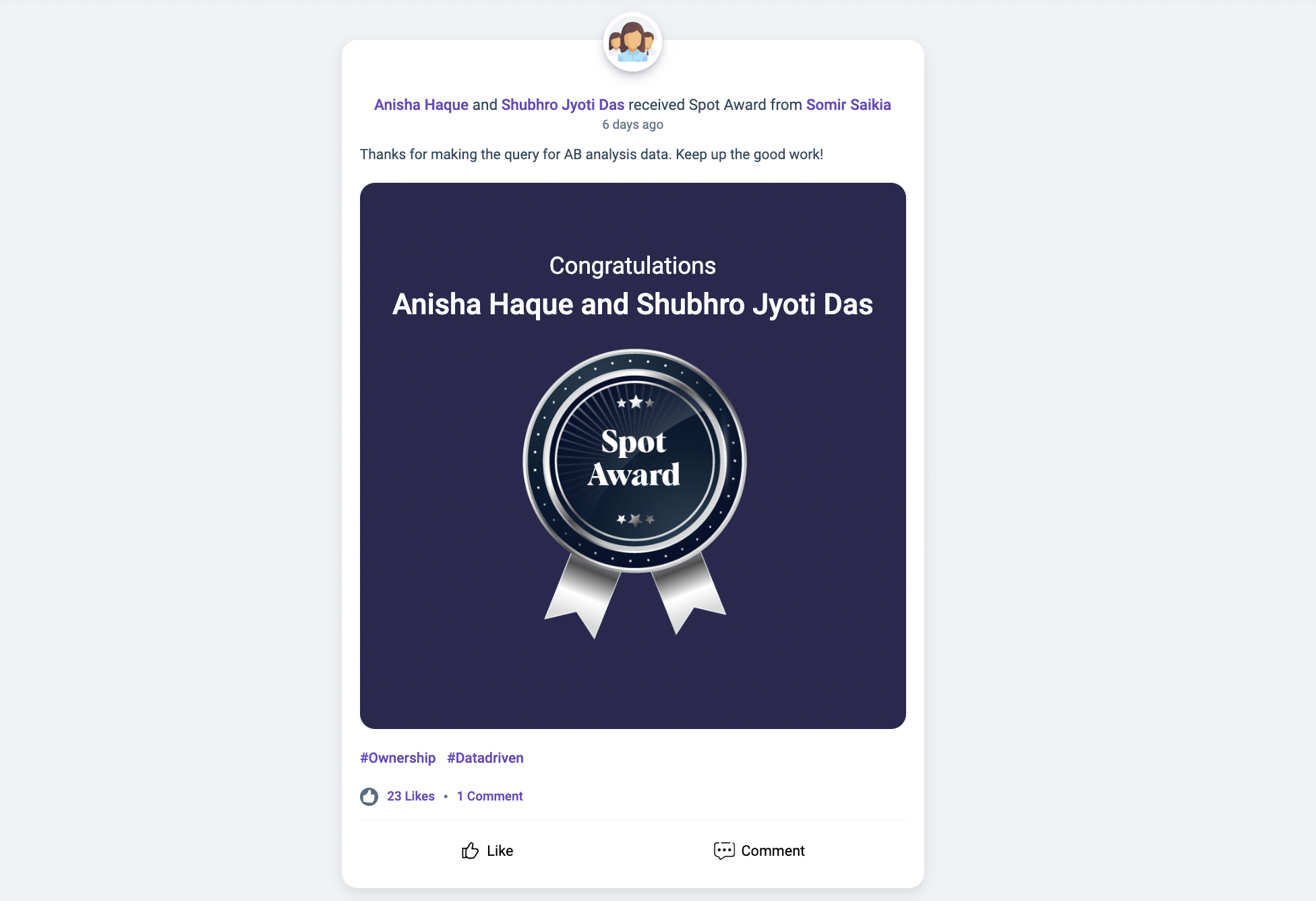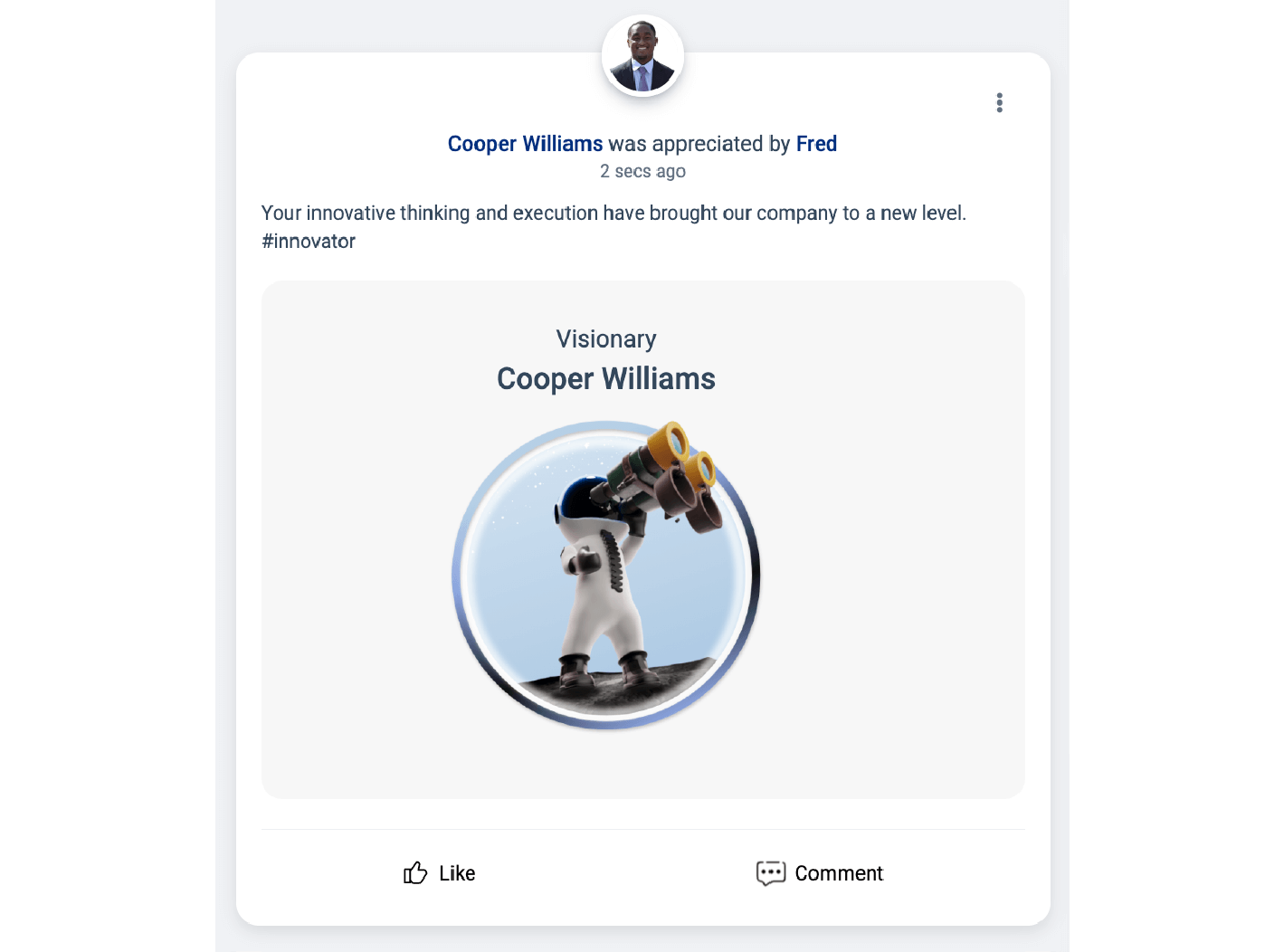The Power of Feedback and Recognition: A Leader's Guide to Driving Performance

A Global Employee Recognition and Wellness Platform
I once sat across from a high-performing team member. She had just closed a major deal and when I congratulated her, she smiled politely and said, “Thanks. But it would’ve meant more coming from leadership.” That moment stuck with me.
Here was someone who was bringing in revenue, exceeding quotas, and making the whole team look good. Yet she felt invisible to the people who mattered most.
Six months later? She jumped ship to a competitor. And honestly, I wasn’t surprised.
Turns out, her story isn’t unique. Studies show that 57 percent of employees quit because of their boss, often due to a lack of meaningful feedback and recognition.
As a leader, you're in the talent retention business whether you signed up for it or not. And the good news is getting feedback and recognition right doesn't require rocket science. All it requires is timing, consistency, and understanding of what makes your people tick. And when you nail this combination, people stay longer and performance skyrockets through the roof.
In this guide, we’ll explore how you can transform your leadership approach to drive results that matter. Trust me, by the time we're done, you'll never look at that weekly one-on-one meeting the same way again.
Feedback vs. Recognition: Understanding the Core Differences to Master Both

Understanding the difference between feedback and recognition is like understanding the difference between a map and a mirror. One guides the way forward, the other reflects where you’ve been. And mastering both is key to building a high-performing, motivated team.
What is Feedback? A Navigational Tool for Future Growth
In today’s workplace, where 85% of employees say they wish they received more feedback and the absence of it is loud.
To be honest, feedback does play a huge role in making any conversation meaningful. It often acts as a navigational tool that can course-correct, find clarity, and stay aligned with organizational goals.
Leaders who give consistent feedback create a culture of transparency and growth. Employees don’t feel blindsided during performance reviews because they’ve already had multiple check-ins along the way. It’s a perfect tool for coaching and building trust that drives continuous improvement.
Read More: What is 360 Degree Feedback? Benefits, Best Practices, Alternatives
What is Recognition? A Reinforcement Tool for Past Contributions
Unlike feedback, recognition focuses on reinforcing positive behaviors and achievements that align with company values. More than just a pat on the back, recognition taps into a basic human need, the desire to feel seen, valued, and appreciated. It’s a powerful way to shine a spotlight on what’s already been accomplished.
Why Viewing Them as Opposites is a Strategic Mistake
After taking the time to highlight how feedback and recognition differ, let’s flip the script, because treating them as entirely separate entities is one of the biggest leadership blunders you can make.
In most organizations, feedback is saved for performance reviews or formal 1:1s. Recognition? They are left for birthdays, work anniversaries, or sporadic shoutouts. But your employees don’t compartmentalize their experience that way.
When Jessica crushes a client presentation, she doesn't think "okay, now I need feedback" and then separately thinks, "I hope someone recognizes this." She experiences it as one cohesive moment where she wants to understand what she did well and how she can build on that success.
Jessica needs someone who not only recognizes her efforts in the moment but also gives her forward-looking feedback to help her grow. Even the data backs it up. According to Gallup, employees who receive both meaningful recognition and frequent feedback are 3.6 times more likely to be engaged.
Think about it! The best leaders don’t run two separate “departments” in their heads, one for praise, one for performance. They blend both into everyday conversations.
How to Incorporate Recognition for More Effective Feedback?
Let’s face it, feedback, no matter how well-intentioned, can be hard to receive. Even your top performers can feel a bit guarded. Why? Because feedback, for many, feels synonymous with criticism. But it doesn’t have to be that way!
According to a Zenger Folkman study, feedback that starts with positive recognition is five times more likely to be accepted and acted upon.
Begin your feedback by highlighting specific strengths or actions. For example, instead of jumping straight into what needs improvement, acknowledge what they've done exceptionally well. Then follow it up with constructive input that builds on those strengths.
Furthermore, be timely. Recognition lands best when it is tied to recent efforts. It makes it feel more authentic and relevant. And be genuine, forced praise does more harm than good.
Recommended Read: Complete Guide to Employee Recognition Surveys: 30 Questions You Need
Recognition Makes Employees Receptive to Feedback

Building Psychological Safety: The Prerequisite for Honest Conversations
Before employees can grow, they need to feel safe. According to research by Google’s Project Aristotle, psychological safety is the #1 factor that high-performing teams have in common.
Feedback, even when delivered with the best intentions, can trigger defensiveness if the environment feels judgmental or high-pressure. That’s why psychological safety is crucial. It’s the foundation for every meaningful conversation.
Think about your own experience receiving feedback. When was the last time you felt genuinely motivated to improve after someone started by highlighting your failures? Contrast that with a time when someone acknowledged your strengths first, then suggested ways to build on them. The difference is striking.
Recommended Resource: What Is Psychological Safety, Why It's Crucial, And Practical Ways To Improve It
Moving From a "Critique" Culture to a "Coaching" Culture

Finding the Strategic Balance: A Framework for Leaders
Many workplaces still operate under a critique culture. Feedback is treated like a performance correction tool, only brought out when something goes wrong. The result? Employees avoid taking risks, new ideas slow down, and performance talks feel stressful instead of supportive.
But there is a better way to do it. Shift your focus from criticism to a coaching mindset. Instead of waiting for problems to emerge, you need to proactively invest in your people's growth. Ask, "how can we build on this?" instead of "what went wrong?". This will transform the entire team dynamic from defensive to developmental.
So how do you find the right balance? Here’s a simple strategic framework:
-
Affirm First: Start every feedback conversation by highlighting what’s working. Recognition sets a positive tone and reinforces behaviors you want to see more of.
-
Align on Purpose: Clarify why the feedback matters and how it connects to the bigger picture or team goals. This turns critique into context.
-
Offer Guidance: Shift the tone from correction to collaboration. When employees feel involved in the solution, they’re more likely to take ownership and follow through.
When to Give Feedback vs. When to Offer Recognition

What most leaders get it wrong is that they treat feedback and recognition like they're following a recipe. They try to deliver them at predetermined intervals without considering timing, context, or the individual's current state of mind. This mechanical approach misses the nuanced reality of human performance and motivation.
Instead, they should develop an intuitive sense for when someone is riding high on a recent success and ready for a new challenge versus when someone is struggling and needs encouragement.
How Leaders Can Weave Feedback and Recognition Into Daily Interactions?
Make Feedback & Recognition Part of the Flow
Don’t reserve feedback and recognition for formal performance reviews or scheduled meetings. Weave them into your daily rhythm such as daily check-ins, post-meeting recaps, or even casual hallway conversations. The more naturally and frequently they occur, the more they shape a culture of continuous improvement and appreciation.
Balance Praise With Insight
Don’t stop at “great job!” Instead, recognize specific actions and tie them to impact. Then, pair that recognition with a forward-looking suggestion. This not only celebrates what went well but also plants a seed for what’s possible next.
Use Micro-Moments Wisely
Leverage brief, intentional touchpoints like a quick thank-you message, a shout-out during in group conversation or a personalized note after a key meeting. These micro-interactions, when tied to specific contributions or feedback, help employees feel seen, supported, and motivated in real time.
Give Feedback When it Hits the best
People are most receptive to feedback when they're actively thinking about improvement. This might be right after completing a project, before starting a new challenge, or when they've specifically asked for guidance.
Build a Habit, Not a Checklist
When feedback and recognition are embedded into your leadership mindset, they stop feeling like one more item on your to-do list. Instead, they become part of how you lead, and your team begins to expect thoughtful guidance and acknowledgment from you.
How to Implement Recognition in Feedback Strategy?

1. Recognize in Real Time, Not Just During Performance Reviews
Recognition loses its impact when it’s delayed. The closer the praise is to the actual behavior, the stronger the reinforcement. In fact, research by SHRM found that 82% of employees feel more engaged when recognition is given immediately rather than at the end of a project.
Make it a habit to call out wins in real time. A quick verbal shoutout, a note in a team meeting, or a post on your recognition platform keeps momentum high and reinforces a culture of gratitude.
Real-time recognition also makes feedback more acceptable. For example, if an employee just led a successful client call, recognizing their composure and clarity immediately opens the door to offer suggestions. This softens the delivery, boosts receptivity, and keeps the momentum going.

Source: Vantage Recognition
2. Tie Recognition to Specific Behaviors and Outcomes
Generic praises might offer a quick boost, but it doesn’t drive long-term performance improvement or learning. For recognition to support your feedback strategy, it must be specific, behavior-based, and linked to outcomes. This level of specificity helps employees understand exactly what they did right and encourages them to repeat it.
This kind of recognition creates a dual benefit. It reinforces a behavior and provides a model for others to emulate. Moreover, specific recognition pairs naturally with constructive feedback. Once you’ve acknowledged a success, you can follow up with feedback that nudges toward even greater impact.
3. Use Recognition for Constructive Feedback
Recognition is more than a morale booster, it prepares the mind to better receive, process, and act on feedback. When employees feel appreciated, their brains produce more dopamine and oxytocin, neurochemicals that enhance trust, openness, and learning. In this positive state, people are far more likely to engage with feedback productively rather than defensively.
A Gallup study found that employees are 30 times more likely to be actively engaged when managers focus on their strengths. This matters because focusing on what’s working opens the door to discussing what could be improved, without shutting the person down.
4. Tie Recognition to Feedback Loops for Continuous Improvement
Recognition isn’t the end of the conversation, it’s the beginning of a performance loop. When you integrate recognition into your feedback cycles, you naturally guide the employee toward growth.
For instance, if an employee delivered a great client pitch, your recognition might highlight their strong storytelling and confidence. Then your feedback can evolve into a growth conversation saying, “You nailed this part, now let’s build on it.” This approach validates success while prompting reflection and action.
5. Use Technology to Scale Personalized Recognition and Feedback
In today’s hybrid and distributed workplaces, relying solely on in-person feedback or sporadic emails just doesn’t cut it. Technology can bridge that gap by making recognition and feedback both consistent and scalable.
Employee recognition platforms like Vantage Recognition do more than just enable managers to deliver timely, meaningful praise tied to company values or goals. It also empowers peer to celebrate each other’s contributions, creating a culture of appreciation that flows across all levels of the organization.

Source: Vantage Recognition
When integrated with feedback mechanisms, like 360 reviews, performance check-ins, or employee pulse surveys , they create a rich ecosystem of continuous, two-way communication.
Advanced Strategies: Overcoming Hurdles in a Diverse Workforce
Leading Fairly: How to Mitigate Unconscious Bias in Praise and Reviews
If truth be told, bias isn't always obvious, and it often resides in our subconscious assumptions. Harvard University research suggests that approximately 70% of people hold some form of unconscious bias. This can sometimes unintentionally influence how we acknowledge and evaluate team members.
The workplace impact of these hidden biases is measurable and significant. For instance, it is seen that women in tech are less likely to receive praise from executives (36%) compared to men (53%), creating a visibility gap that directly affects advancement opportunities.
So, how should leaders ensure fairness? They should:
-
Use Clear Criteria For Recognition: Instead of relying on gut feeling or personal impressions, base your praise on specific actions and results. Create a simple checklist or rubric that outlines what good performance looks like.
-
Make Sure Everyone Gets a Chance to be Recognized: Avoid always spotlighting the same group of employees. Rotate who gets to nominate others or give shout-outs so recognition doesn’t stay within just one team.
-
Train your Team to Spot and Challenge Bias: Offer regular training that helps employees and managers understand their own unconscious biases, especially around race, gender, or background. This kind of learning helps people give more balanced and respectful recognition.
-
Get More than One Perspective When Reviewing Performance: Bring in peer reviews or rotate who gives feedback, so you get a more well-rounded view of someone’s contributions.
Adapting Your Style: A Guide for Generational and Global Teams
We’re working in the most diverse workforce in modern history. And that diversity goes beyond race or gender, it spans generations and geography. For the first time, Baby Boomers, Gen X, Millennials, and Gen Z are all sharing the same workplace, each with distinct preferences and expectations.
Here’s how to effectively navigate the nuances of generational and global team dynamics:
-
Don’t Guess, Ask your Team What They Prefer: The best way to understand their preference is to ask. Incorporate a quick question in your 1:1s or use pulse surveys. It’s a simple habit that builds trust.
-
Be Culture-aware: What’s considered meaningful praise in one culture may feel awkward, or even inappropriate in another. Therefore, start by learning about the cultural makeup of your team, especially if you're working with a global workforce. Then tailor your feedback and recognition style accordingly.
-
Lead with Empathy: Take the time to understand what truly drives your employees, what keeps them motivated and makes them feel valued. Empathetic leaders don’t just celebrate the end results; they acknowledge the effort and the setbacks it took to get there.
Conclusion
At its core, feedback shapes the future while recognition honors the present. But when leaders learn to blend the two, they unlock something far more powerful.
So, don’t wait for the next performance review cycle. Start today. Use a micro-moment, a quick check-in, or a simple thank-you to reinforce what’s working and guide your people toward what’s next. Because when feedback and recognition become second nature, so does high performance.


















